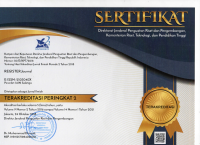Whites and Browns: A Contrastive Study of Metadiscourse in English Newspaper Editorials
Abstract
Metadiscourse is an interesting field of inquiry that is believed to play a vital role in organizing and producing persuasive writing. It is a set of linguistic devices used to communicate attitudes and mark the structural properties of a text. The study aimed to investigate whether native and non-native varieties of English varieties are similar or different from each other from the perspective of interactional meta-discourse markers. The study as contrastive rhetoric research scrutinized a corpus of 900 newspaper editorials (450 written in native English newspapers and 450 written in non-native English newspapers). Editorials were culled from 15 native English newspapers belonging to three native English countries, England, America, and New Zealand, and 15 non-native English newspapers belonging to three non-native English countries, Pakistan, India, and Sri Lanka. Based on the model of metadiscourse given by Hyland (2005), interactional metadiscourse resources were analyzed. The frequencies of interactional metadiscourse markers in both native and non-native varieties were counted and compared with each other. The results disclosed that there were worth-pointing differences between the native and non-native English editorialists in the use of interactional metadiscourse markers. Two different varieties of English editorials showed variations particularly in the use of hedging and self-mention markers. On the whole, findings suggested that the use of interactional metadiscourse markers in native English editorials were more frequent than those in non-native English editorials which made their writings more appealing and convincing context.
Keywords: metadiscourse; native; non-native; newspaper; editorials
Full Text:
PDFReferences
Ansary, H., & Babaii, E. (2009). A cross-cultural analysis of English newspaper editorials: a systemic-functional view of text for contrastive rhetoric research. RELC Journal, 40(2), 211-249.
Bhatia, V. (1993). Language use in professional settings. Applied Linguistics and Language Study). Longman.
Connor, U. (1996). Contrastive rhetoric: Cross-cultural aspect of second-language writing. Cambridge University Press.
Crismore, A. (1984). The rhetoric of textbooks: Metadiscourse. Journal of Curriculum Studies, 16(3), 279-296.
Crismore, A., Markkanen, R., & Steffensen, M. S. (1993). Metadiscourse in persuasive writing: A study of texts written by American and Finnish university students. Written Communication, 10(1), 39-71.
Dafouz, E. (2003). Metadiscourse revisited: A contrastive study of persuasive writing in professional discourse. Estudios Ingleses de la Universidad Complutense, 11, 29-52.
Fowler, R. (1991). Language in the News: Discourse and ideology in the press. London: Routledge.
Fuertes-Olivera, P. A., Velasco-Sacristán, M., Arribas-Baño, A., & Samaniego-Fernández, E. (2001). Persuasion and advertising English: Metadiscourse in slogans and headlines. Journal of Pragmatics, 33(8), 1291-1307.
Ghahremani Mina, K., & Biria, R. (2017). Exploring Interactive and Interactional Metadiscourse Markers in Discussion Sections of Social and Medical Science Articles. International Journal of Research in English Education, 2(4), 11-29.
Harris, Z. S. (1959). The transformational model of language structure. Anthropological linguistics, 27-29.
Hyland, K. (1994). Hedging in academic writing and EAF textbooks. English for Specific Purposes, 13(3), 239-256.
Hyland, K. (1998a). Persuasion and context: The pragmatics of academic metadiscourse. Journal of Pragmatics, 30, 437-455.
Hyland, K. (1998b). Boosting, hedging, and the negotiation of academic knowledge. Text-Interdisciplinary Journal for the Study of Discourse, 18(3), 349-382.
Hyland, K. (1999). Talking to students: Metadiscourse in the introductory coursebook. English for Specific Purposes, 18(1), 3-26.
Hyland, K. (2000). Disciplinary Discourses: Social Interactions in Academic Writing. Longman.
Hyland, K. (2001). Humble servants of the discipline? Self-mention in research articles. English for Specific Purposes, 20, 207-226.
Hyland, K. (2004). Disciplinary discourses, Michigan classics ed.: Social interactions in academic writing. University of Michigan Press.
Hyland, K. (2005). Metadiscourse: Exploring interaction in writing. Continuum.
Hyland, K. (2007). Genre pedagogy: Language, literacy, and L2 writing instruction. Journal of Second Language Writing, 16(3), 148-164.
Hyland, K. (2010). Metadiscourse: Mapping interactions in academic writing. Nordic Journal of English Studies, 9(2), 125-143.
Kaplan, R. B. (1966). Cultural thought patterns in intercultural education. Language Learning, 16 (1), 1-20.
Kuhi, D., & Mojood, M. (2012). A contrastive study of metadiscourse in English and Persian editorials. The Journal of Applied Linguistics, 5(1).
Mauranen, A. (1993). Contrastive ESP rhetoric: Metatext in Finnish-English economics texts. English for Specific Purposes, 12(1), 3-22.
Moreno, A. I. (1997). Genre constraints across languages: Causal metatext in Spanish and English RAs. English for Specific Purposes, 16(3), 161-179.
Milne, E. (2008). The Pragmatic Role of Textual and Interpersonal Metadiscourse Markers in the Construction and Attainment of Persuasion: A Cross-Linguistic Study of Newspaper Discourse. Journal of Pragmatics, 40(1), 95-113.
Mur-Dueñas, P. (2011). An intercultural analysis of metadiscourse features in research articles written in English and Spanish. Journal of Pragmatics, 43(12), 3068-3079.
Shahid, M. I., Qasim, H. M., & Hasnain, M. (2020). A cross-linguistic study of metadiscourse in English and Urdu newspaper editorials. Corporum: Journal of Corpus Linguistics, 3(1), 33-56.
Siddique, A. R., Mahmood, M. A., & Iqbal, J. (2018). Metadiscourse analysis of Pakistani English newspaper editorials: A corpus-based study. International Journal of English Linguistics, 8(1), 146-163.
Valero-Garcés, C. (1996). Contrastive ESP rhetoric: Metatext in Spanish-English economics texts. English for Specific Purposes, 15(4), 279-294.
DOI: https://doi.org/10.18326/rgt.v14i1.25-42
Refbacks
- There are currently no refbacks.
Copyright (c) 2021 Muhammad Imtiaz Shahid, Hafiz Muhammad Qasim, Muhammad Hasnain

This work is licensed under a Creative Commons Attribution-ShareAlike 4.0 International License.










